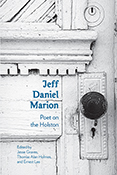Jeff Daniel Marion
Poet on the Holston

- Author(s): Lee, Ernest, Ed., Editor Jesse Graves, Editor Thomas Alan Holmes
- Series:
- Imprint: Univ Tennessee Press
- Publication Date: 2015-11-30
- Status: Active
- Available in Paper: Price $29.95 | Buy Now
- Leaf eReader required for PDF ebooks
The author of nine volumes of poetry and numerous other writings, the editor of several literary journals, the recipient of copious awards, including the James Still Award from the Fellowship of Southern Writers, and a longtime teacher and mentor, East Tennessee native Jeff Daniel Marion has come to be known as one of the most significant and beloved voices in Appalachian literature over the past four decades. The twenty-one pieces in this illuminating collection range from examinations of Marion’s poetry to considerations of his teaching career and influence on students, writers, and artists throughout the region and beyond.
Acclaimed poet, novelist, and historian Robert Morgan writes about how Marion affected his development as a writer and the key role Marion has played in bringing Appalachian literature into its own. Scholar Randall Wilhelm’s essay, meanwhile, expands our appreciation for Marion not only as a poet but as a visual artist, tracing the connection between his photography and poetic imagery. Also included are essays by John Lang on the ways in which Marion’s poetry “gives voice to a spiritual vision of nature’s sacramental identity,” Gina Herring on how the poet’s father has served as his muse, and George Ella Lyon on the power of story in Marion’s picture book for children, Hello, Crow. Other features include an autobiographical essay by Marion himself, an interview conducted by coeditor Jesse Graves, and a bibliography and timeline that summarize Marion’s life and career.
In the book’s introduction, Ernest Lee notes that in the poem “Boundaries,” from his first published collection, the young Marion “dedicated himself to his place, to the land and his heritage . . . welcoming whatever may come with a firm faith that ultimately his life as a poetic laborer will bring him to a true, sharp vision.” The eloquent contributions to this volume reveal just how fully that dedication has paid off.
